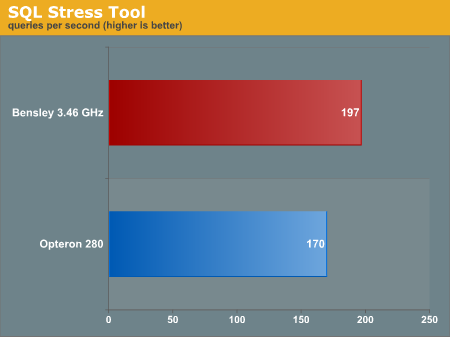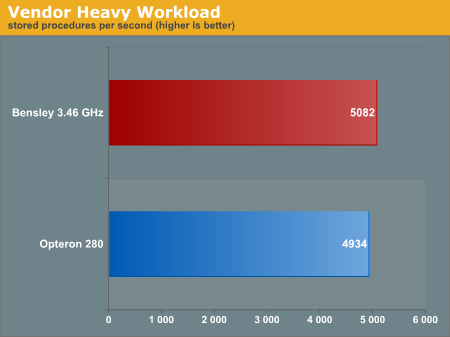Intel’s Dual-Core Xeon First Look
by Jason Clark & Ross Whitehead on December 16, 2005 12:05 AM EST- Posted in
- IT Computing
SQL Stress Tool Results(test description)
Intel’s pre-production Bensley system came out on top in this test, with a 14% lead over the Opteron 280 system. The 1066MHz front-side bus, no doubt, was required to achieve this result, along with the 2MB of L2 cache. Intel has always been competitive with AMD in this test, but was able to pick up an additional 4% this time around over their usual 10% lead.
This enterprise test has been of great interest to a lot of people, including Intel. Opteron has constantly dominated this test, but times have changed. Bensley essentially tied with the Opteron 280 in this test, as the difference was about 3% (which is standard deviation). The new Blackford chipset architecture, increased front-side bus and memory bandwidth all played a part in Bensley showing this kind of improvement. Where Opteron used to show, on average, a 15% gain over Intel, they are now neck and neck.
Intel’s pre-production Bensley system came out on top in this test, with a 14% lead over the Opteron 280 system. The 1066MHz front-side bus, no doubt, was required to achieve this result, along with the 2MB of L2 cache. Intel has always been competitive with AMD in this test, but was able to pick up an additional 4% this time around over their usual 10% lead.

This enterprise test has been of great interest to a lot of people, including Intel. Opteron has constantly dominated this test, but times have changed. Bensley essentially tied with the Opteron 280 in this test, as the difference was about 3% (which is standard deviation). The new Blackford chipset architecture, increased front-side bus and memory bandwidth all played a part in Bensley showing this kind of improvement. Where Opteron used to show, on average, a 15% gain over Intel, they are now neck and neck.











67 Comments
View All Comments
Furen - Sunday, December 18, 2005 - link
I think the comparison is fair enough considering that Benseley should be coming out within the next 3-5 months. The most I'd expect from AMD by then is maybe a bump in clock speed. Socket F is scheduled to come out in Q4 2006, if I remember correctly, and mentioning it would serve no purpose since we know absolutely nothing about it.Heinz - Monday, December 19, 2005 - link
Ok, if your information would be correct I would agree, however Socket F is due to H1/2006, i.e. the same 3-5 month timeframe we have to wait for Bensley. Thus Bentley is not competing with the tested S940 Sytem but with a Socket F System.Look here:
http://www.pcstats.com/NewsView.cfm?NewsID=46731">http://www.pcstats.com/NewsView.cfm?NewsID=46731
Apart from that, I do not see your point about not being interested in Socket F at all. Of course, there is little information about it, but what it is sure is that it will be presented in 2006. Because new product generations are normally faster/better than the old ones (old tradition in the computer, if not any market ;-). I would be interested to know that.
It is like saying the new Volkswagen is next year best car on the market, because it is better than the current competition, without mentioning that there will also be a new Toyota model.
If the information from pcstats is incorrect and anandtech got better information about a delayed/later launch of the Socket F platform, I apologize. But then again ... it should have been mentioned in the article :)
byebye
Heinz
Furen - Thursday, December 22, 2005 - link
Interesting, that's the first time I've seen that road map. I was kind of hoping that Socket F would come out at the end of the year with FB support, since I think tri/quad-core CPUs may be bandwidth limited with two DDR2 channels, then again the fact that they'll be DDR667 dimms may help enough.IntelUser2000 - Friday, December 16, 2005 - link
The first Intel dual core for dual core servers is out and the CPU is called Paxville. It uses the aging Lindenhurst chipset with single 800MHz FSB while Bensley will use dual 1066FSB. The highest clock for Paxville is 3.0GHz.http://www.realworldtech.com/page.cfm?ArticleID=RW...">http://www.realworldtech.com/page.cfm?ArticleID=RW...
It says Bensley with Dempsey will be out Q1 of 2006.
http://www.theinquirer.net/?article=27789">http://www.theinquirer.net/?article=27789
3.2 and 3.46GHz will be 1066FSB.
2.5, 2.83 and 3GHz will be 667FSB.
MV versions will be 3.2GHz with 1066FSB.
LV versions will be 2GHz with 667FSB(ouch).
coldpower27 - Friday, December 16, 2005 - link
Interesting, though with that projected clock frequency on the LV Dempsey, they might as well use the Sossaman processor. As the Roadmap in this article no longer points out LV Dempsey parts.
Griswold - Friday, December 16, 2005 - link
Mostly information I didnt ask for / can be found in the AT article. Thank you for that.Frallan - Friday, December 16, 2005 - link
I dont mind that AMD has held the lead for quite some time bc they needed it badly. But it wasn't good that Intel had nothing that could compare. Now at least Intel is on the map again as AMD which might acctually force AMD to go a bit faster again.Then on the topic of power, if it is 8k, 20k or 50k you save per year by buying product A instead of B isn't important if everything else is equal. 8k is more then enough to rule in favour of AMD (remember everything else equal).
The future looks interestin and Im gonne pick a Denmark up soon :0)
menting - Friday, December 16, 2005 - link
problem is that even if performance is equal..price parity on the cost of servers aren't... :)you get a huge discount if you go mostly intel.
phaxmohdem - Friday, December 16, 2005 - link
Wow! A Dual core server/workstation chip. Way to go Intel! AMD better get its $hit together soon.... Oh wait...Do they make a special Silver stake or bullet that will ever kill fvcking Netburst?
coldpower27 - Friday, December 16, 2005 - link
These are probably the last NetBurst based server processor you will see for this segement, the next slated update is Woodcrest core over the Dempsey core used now, which is part of Intel's NGMA.